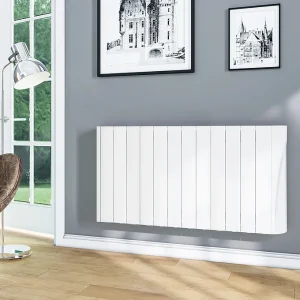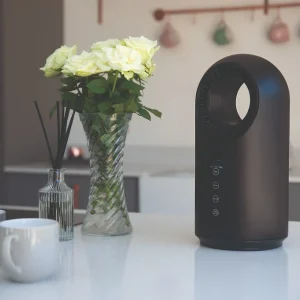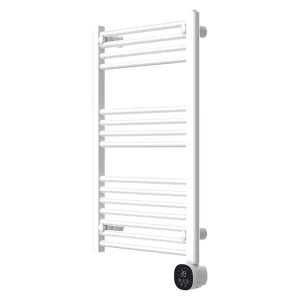Heating your home efficiently is more important than ever, with rising energy costs and increasing interest in smart technology. A smart heating system offers a way to stay comfortable while cutting down on energy waste, adapting to your schedule, and integrating with other smart home devices. But with so many options available, how do you choose the right one? In this guide, we will explore the best smart heating systems in the UK and what to look for when making your decision.
What is a smart heating system?
A smart heating system is an advanced way of controlling home heating, using internet-connected devices to optimise temperature settings based on user habits, schedules, and environmental factors. Unlike traditional thermostats, which require manual adjustments, smart heating systems can be controlled remotely via smartphone apps, voice assistants, or automation features that learn from daily routines.
Benefits of a Smart Heating System
- Energy Savings – Smart heating systems reduce energy waste by only heating occupied areas and adapting to daily routines. By learning user behaviour and adjusting temperatures accordingly, they prevent unnecessary heating when no one is home. Some systems also provide detailed insights into energy consumption, allowing you to track usage patterns and make informed adjustments to save on heating bills.
- Convenience & Remote Access – Users can control heating from anywhere via mobile apps, ensuring the home is warm when needed without unnecessary heating when away. This is particularly useful for those with irregular schedules or for times when plans change unexpectedly. Some systems also offer geofencing, which automatically turns heating on or off based on the user’s location, ensuring comfort without manual intervention.
- Zonal Control – Smart radiator valves enable room-by-room temperature management, preventing overheating and providing personalised comfort. Instead of heating the entire house, users can set different temperatures for individual rooms, reducing energy waste in unused spaces. This is especially beneficial for larger homes or households with varying heating preferences among family members.
- Integration with Smart Homes – These systems can connect with other smart devices, such as lighting and security systems, creating a fully automated home environment. Integration with voice assistants like Alexa, Google Assistant, or Apple HomeKit allows users to adjust heating through voice commands. Some systems even link with smart lighting and blinds to enhance energy efficiency by coordinating heating with natural daylight.
- Weather Adaptability – Some systems adjust heating based on outdoor temperatures, further improving efficiency. By responding to sudden drops or rises in temperature, they prevent overuse of energy while maintaining a comfortable indoor climate. Advanced systems can also use weather forecasts to proactively adjust heating, ensuring optimal warmth without unnecessary energy consumption.
How smart heating systems work?
A smart heating system typically includes a central smart thermostat, wireless sensors, and sometimes smart radiator valves. These components communicate with each other and a central hub, allowing you to control heating settings in different rooms, schedule heating times, and even respond to weather changes in real time. Many systems integrate with home assistants like Amazon Alexa, Google Assistant, or Apple HomeKit for seamless voice control.
Best Smart Heating Systems in the UK
Here are some of the best smart heating systems available, considering compatibility, features, and ease of use.
Nest Learning Thermostat (3rd Gen)
- Auto-schedules heating based on usage patterns – The thermostat learns your daily routines and preferences over time, automatically adjusting heating schedules to match your habits without requiring manual programming.
- Works with Google Assistant and Alexa – You can control the thermostat with simple voice commands, making it easy to adjust the temperature hands-free through smart home assistants like Google Assistant or Alexa.
- Learns user preferences to optimise heating efficiency – The Nest thermostat adapts to seasonal changes and user behaviour, ensuring optimal comfort while reducing energy waste.
- Offers remote control via the Nest app – You can monitor and adjust your heating from anywhere using the Nest app, whether you’re at work, on holiday, or just in another room.
- Integrates with smart home ecosystems – The Nest thermostat works seamlessly with a range of other smart home devices, including smart lighting, security systems, and even some renewable energy solutions like solar panels.
Hive Active Heating
- No subscription required for basic features – Unlike some smart heating systems, Hive offers full control of heating and scheduling without requiring a paid subscription for core functions.
- Works with Alexa, Google Assistant, and Apple HomeKit – The system supports voice control through multiple platforms, ensuring flexibility for different smart home setups.
- Geolocation feature adjusts heating when you leave or return home – Hive uses your smartphone’s location to turn the heating off when you leave and back on when you return, helping to save energy without sacrificing comfort.
- Easy-to-use app with scheduling and remote access – The Hive app allows users to set daily or weekly schedules, adjust temperatures in real-time, and monitor energy usage with an intuitive interface.
- Compatible with a range of boiler types – Whether you have a combi, conventional, or system boiler, Hive is designed to work with most central heating systems in UK homes.
Tado Smart Thermostat Starter Kit V3+
- Features geofencing to adjust heating when occupants leave or return – Tado detects when the house is empty and lowers the temperature, then warms it up again when it senses someone is on the way home.
- Offers detailed energy reports and smart scheduling – Users receive insights into their heating habits and energy consumption, helping them optimise settings for better efficiency and lower bills.
- Compatible with Alexa, Google Assistant, and Apple HomeKit – Works with all major voice assistants, providing flexibility for users who prefer voice control.
- Can be expanded with smart radiator valves for zonal control – Unlike some thermostats that only control a single temperature setting for the entire house, Tado allows you to install smart radiator valves to heat individual rooms differently, reducing unnecessary energy use.
Drayton Wiser Multi-Zone Smart Heating
- Allows independent control of different rooms with smart radiator valves – This system is perfect for larger homes, as it enables users to set different temperatures for different rooms, ensuring greater energy efficiency and personal comfort.
- Works with Alexa, Google Assistant, and Apple HomeKit – The system integrates with major smart home platforms, allowing voice control and automation through your preferred assistant.
- Boost mode for quick temperature adjustments – If you need a rapid temperature increase, the boost function temporarily raises the heating to a higher level before returning to normal settings.
- Offers open-window detection to prevent energy waste – The thermostat can detect sudden drops in temperature caused by open windows and temporarily switch off heating to avoid unnecessary energy consumption.
Bosch EasyControl Smart Thermostat
- Designed for Bosch boilers but compatible with other systems – While it works best with Bosch boilers, this thermostat is also compatible with a range of other central heating systems, making it a flexible choice.
- Individual room control with smart radiator thermostats – Users can install Bosch smart radiator valves to create zonal heating, allowing different temperatures for different rooms.
- Learning function adapts to user routines – Over time, the system adjusts its settings based on your habits, ensuring an optimal balance between comfort and energy efficiency.
- Works with Amazon Alexa and Google Assistant – You can control heating settings using voice commands, making adjustments quick and convenient.
Each of these smart heating systems has its strengths, so the best choice depends on your home setup, budget, and the level of automation you prefer.
Choosing the Right Smart Heating System
When selecting a smart heating system, consider the following factors to ensure it meets your needs for efficiency, convenience, and compatibility.
- Compatibility – Ensure it works with your existing boiler and heating setup. Some systems, like the Bosch EasyControl, are designed primarily for Bosch boilers but can also work with other systems, while others like Hive Active Heating are compatible with a wide range of boiler types, including combi, conventional, and system boilers. Before purchasing, check if the thermostat and any additional components (such as smart radiator valves) are suited to your current heating system to avoid installation issues.
- Smart Integrations – If you use smart home assistants or other smart devices, choose a system that integrates seamlessly. Nest Learning Thermostat and Tado Smart Thermostat work with Google Assistant, Amazon Alexa, and Apple HomeKit, allowing voice control and easy integration into an existing smart home ecosystem. Some systems, like Drayton Wiser, go beyond basic heating control and integrate with smart lighting or security systems for a fully automated home experience. If voice commands or home automation are important, make sure your chosen system supports the platforms you use.
- Features & Automation – Geofencing, learning algorithms, and zonal control can improve efficiency and comfort. Tado and Hive Active Heating both use geolocation technology, automatically adjusting heating when you leave or return home, saving energy without requiring manual adjustments. Nest Learning Thermostat learns your schedule over time, optimising heating automatically, while Drayton Wiser offers multi-zone control with smart radiator valves, allowing different temperatures in different rooms. Consider which automation features will provide the most convenience and energy savings for your lifestyle.
- Ease of Use – A user-friendly app and simple installation process make a significant difference. Hive Active Heating is known for its straightforward installation and an intuitive mobile app, making it an excellent choice for those new to smart heating. Tado, on the other hand, offers a sleek, easy-to-navigate app with detailed energy reports, helping users track and optimise their heating habits. Some systems require professional installation, while others, like Drayton Wiser, are designed for easy self-installation. If you prefer a plug-and-play experience, prioritise a system with a well-designed app and minimal setup complexity.
- Budget – Costs vary, from affordable entry-level options to advanced multi-zone systems. Basic smart thermostats, such as Hive Active Heating, provide essential smart features at a lower price point without requiring a subscription for core functionalities. On the other hand, premium systems like Nest Learning Thermostat and Tado V3+ offer advanced automation and energy insights, often at a higher upfront cost, with optional expansions like smart radiator valves for zonal heating. If you want multi-zone control, factor in additional costs for radiator valves and other accessories. Consider both the initial investment and potential long-term energy savings when deciding on the best system for your budget.
By weighing these factors carefully, you can choose a smart heating system that not only enhances comfort but also maximises energy efficiency and integrates seamlessly with your home.
Conclusion
Investing in a smart heating system can lead to significant energy savings, improved comfort, and seamless home automation. With options like Nest Learning Thermostat for adaptive heating, Tado for geofencing, and Drayton Wiser for zonal control, you can find a system that matches their lifestyle and heating needs. The key is to choose a system that is compatible with your existing setup, integrates with your smart home devices, and offers the right balance of automation and ease of use. By selecting the best smart heating system, you can optimise energy consumption while ensuring your home stays warm exactly when you need it.





